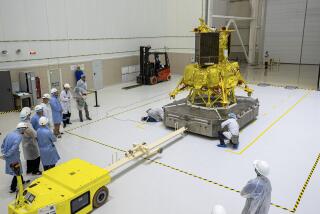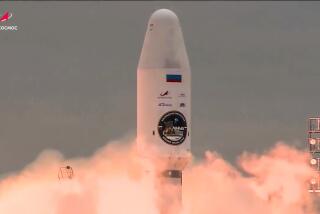A Shot in the Dark: Russians Call Space Mirror a Success
- Share via
MOSCOW — Russian scientists proclaimed success Thursday in an experiment straight out of science fiction: the unfurling of a large mirror in space meant to demonstrate that northern cities can someday be lit by sunlight reflected from the daytime side of the planet.
Officials at the Flight Control Center near Moscow said the shiny disc, nearly 25 yards across and covered in a super-thin layer of aluminum, opened out like an umbrella. Cosmonauts floating nearby in the space station Mir could see the shaft of light that it sent to Earth, the official said.
In Toulouse, France, residents reported that they saw two bright spots pass through the sky in the early morning--one described them as “two luminous diamonds”--but that they did not appear to light up the ground, according to the British news agency Reuters. Reports of flashes of light also came from Belarus.
Still, said Nikolai Prokofiev, a spokesman for the Flight Control Center, “I would say it went very successfully.”
“The construction opened and we positioned it in the sun so that we sent a reflection across the shady side of the Earth,” he said. “We did indeed send off that reflection.”
Russian television showed film footage of the mirror taken by the cosmonauts on Mir, the permanently orbiting Russian space station. The film showed the reflector, looking like a giant silver pinwheel, spinning above the blue and white of the Earth. But it did not capture any spot of light that the disc may have cast down below.
The cosmonauts unfolded the shiny disc at about 4 a.m. Moscow time, Prokofiev said. At 5:17 a.m. they tried rocking it and turning it to test its maneuverability, and from 8:17 a.m. to 8:27 a.m. they sent the ray of light across Europe. At 8:35 a.m., the experiment over, they shot the mirror off into space.
The mirror was launched from the Mir station’s supply ship, known as the Progress. The Progess moved 150 yards away from the Mir, then began to unfold the mirror, which the cosmonauts had mounted in the hatch of its docking unit, according to the Itar-Tass news agency.
The light that it focused on Europe was estimated to be two miles wide on the ground. As the Earth turned beneath the disc, the light raced at about 5 miles a second across Europe, from west to east.
“We have shown that you can in fact illuminate places on Earth with the help of such reflectors,” Prokofiev said.
Russian scientists are touting the idea of a space reflector as a method to light up emergency zones when all power is out and whole northern cities where dark reigns throughout the winter. They say that several reflectors together would produce a spotlight strong enough to illuminate points on Earth.
The mirror used Thursday could also serve as the prototype for a solar sail, they said. A solar sail, until now only a much-beloved dream of scientists, would be a shiny, super-light disc powered by the tiny charges that come from the particles the sun emits.
More to Read
Sign up for Essential California
The most important California stories and recommendations in your inbox every morning.
You may occasionally receive promotional content from the Los Angeles Times.










